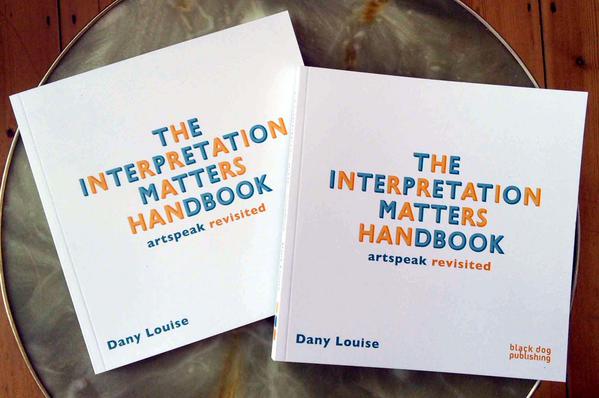
Book Review: The Interpretation Matters Handbook
Should textual information in galleries be made easier to understand? Jennifer Locke reviews Dany Louise’s contribution to the debate around ‘artspeak’.
Art galleries are renowned for using complex language in discussing works of art. Dany Louise’s ‘Interpretation Matters Handbook: artspeak revisited’ sets out to examine the practices of written interpretation in art museums and galleries, debating whether textual information in galleries could be made simpler and easier to understand. The book is a collection of essays, interviews, opinion pieces and case studies that provide the reader with food for thought about the kind of language used in the art world and highlights some of the debates surrounding the interpretation of art in galleries.
The Interpretation Matters Handbook is part of Louise’s ‘Interpretation Matters!’ project, which works with art galleries to experiment with different ways of producing textual interpretation. Louise is passionate about the subject, and it is clear from this book that she wants galleries to communicate better with their audiences.
In one of the first sections of the book, Louise, a professional writer who writes about the visual arts and cultural policy, identifies seven problems with art writing. These problems range from forcing too much information on the reader, to ‘nonsense writing’, or the way text in galleries can sometimes sound garbled. She uses three examples of texts found in galleries and provides the reader with an analysis of their strengths and weaknesses. Her opinions on what makes a text label clear, informative and engaging are accurate, and her advice would be useful at any exhibition planning meeting.
Sections of the book are dedicated to examining the work of Tate Britain, which has recently removed a large amount of textual information from the walls in its permanent collection displays. An interview with outgoing Director Dr Penelope Curtis sheds light on the reasoning behind this move, while arts professionals Bridget McKenzie and Jessica Hoare give contrasting opinions on the new displays. As one of the most recent examples of a large institution experimenting with interpretation practices, it is informative to read about Tate’s approach from various points of view.
The book also features several artists’ perspectives, including those of Emily Speed, David Blandy, Richard Wilson Luborimov-Easton and Alistair Gentry, each of whom provide their own ‘take’ on the use of art language. Curators Lewis Biggs, Omar Kholeif and Gerardo Mosquera talk with Louise about the challenges of their roles and give their views on written interpretation. Other sections of the book feature the opinions of artistic directors, academics and of Louise herself. The varied viewpoints challenge the reader’s assumptions, providing a range of ideas that will further the debate on how galleries, artists and the art world at large use written language.
The Interpretation Matters Handbook is written for the arts professional, artist or interested gallery-goer, not necessarily the academic – although students will find some of the content useful and interesting. In truth, it’s not really a ‘handbook’, but more a collection of interesting and thoughtful articles on the subject.
The Interpretation Matters Handbook is an interesting resource for dipping in and out of, and also for stimulating discussion and dialogue about what is ultimately a highly contested topic. There is, of course, no right or wrong answer as to how art should be interpreted, or the form in which this interpretation takes – but if you are interested in breaking down the barriers to art, engaging in debate about how galleries communicate, or simply want something thought-provoking to read, the Interpretation Matters handbook is well worth a look.
Jennifer Locke is a PhD researcher at Newcastle University.
www.ncl.ac.uk
Join the Discussion
You must be logged in to post a comment.